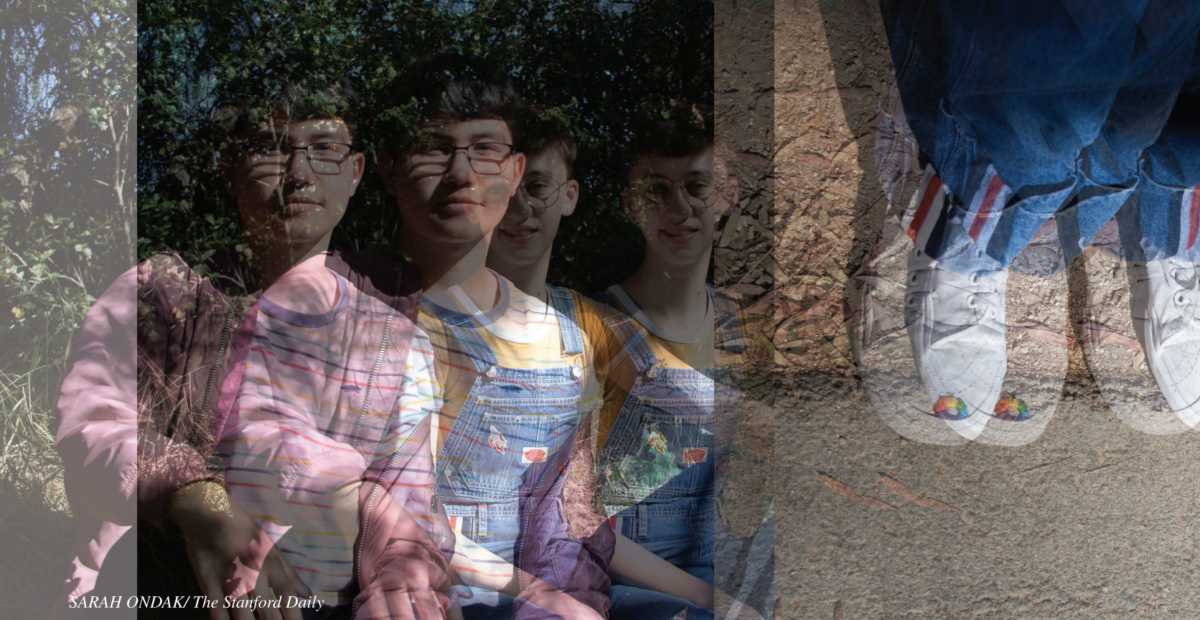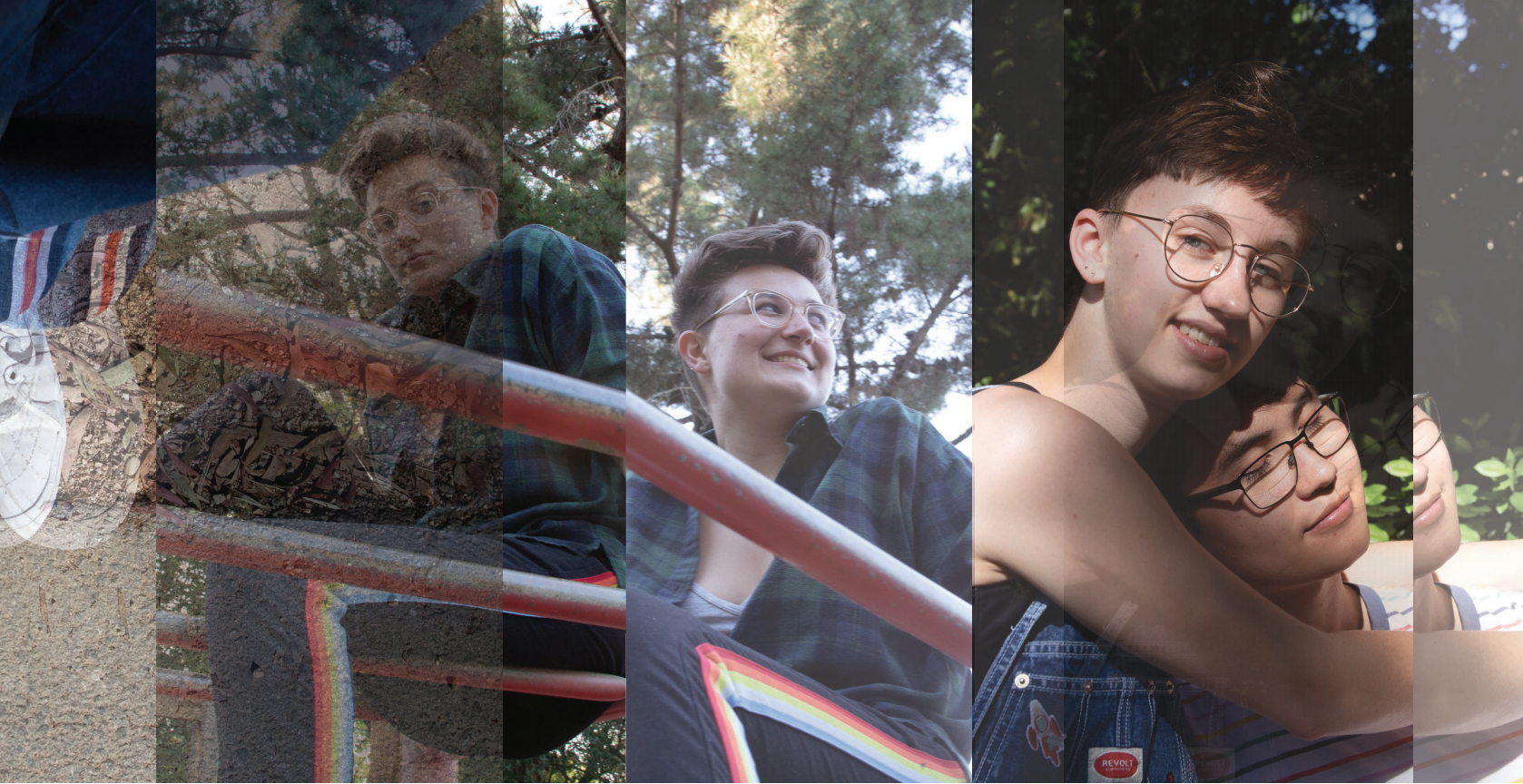Annabel Conger ’21 stares at a small mirror, assessing a pair of dark blue, baggy overalls. This is the fourth outfit Conger has tried on in the past 20 minutes before joining a crowd of students in the courtyard of 539 Cowell Lane. Otherwise known as Terra, the co-op is the unofficial LGBTQ+ house on Stanford’s campus. As Conger cycles through outfits, pulling one shirt after another from the closet, Conger grows exasperated, sighing as each look seems more like a costume than an authentic expression of identity.
In this moment, identity is at the forefront of their mind. In early October, Conger abandoned she/her pronouns and began using they/them. In addition to shedding these female identifiers, they also cast off dresses, skirts and crop tops in exchange for men’s jeans, oversized sweaters and leather sneakers.
Like 16 other residents of Terra, Conger doesn’t identify as cisgender, or someone whose gender identity matches the sex they were assigned at birth. Because of this, almost every day is a war with their closet.
“It’s been a balancing act between the person who was assigned female at birth, who was taught to always be cute and presentable and up for consumption and that always wants to be in the cutest clothes that the most people will like, versus the part of me that is trans and doesn’t want to be in feminine clothes,” they said.
Conger is not alone in this sentiment. For transgender, nonbinary and gender-nonconforming people, or any individual who doesn’t identify with the gender they were first assigned, clothing often presents a challenge. Most clothing doesn’t fit correctly and many outfits can cause body dysphoria, a condition that leaves someone like Conger obsessing over any “flaws” they can find in the mirror.
But the process of finding the perfect outfit can be euphoric. Although members of the LGBTQ+ community may struggle with the conventional gender expression that some clothing conveys, they also use it to subvert gender norms.
Trans representation in the fashion industry remains rare, but publications like Teen Vogue, Refinery29 and Out Magazine have reported the rising number of trans models and LGBTQ+ inclusive runway shows at New York Fashion Week. Combined with coverage of nationally recognized voices like Caitlyn Jenner and Laverne Cox and the advocacy of trans models Andreja Pejic and Hari Nef, a few prominent people within the fashion industry have helped to increase trans representation in popular culture.
However, much of society’s understanding of trans identity seems to rest on these one or two well-known voices. In reality, anyone can contend with questions surrounding gender identity and how to authentically present themselves.

For Brandon Alvarez ’19, gender presentation was initially confusing.
“When I first came to college… I definitely cycled through a lot of aesthetics and styles,” Alvarez said. “I didn’t know what … gender dysphoria [was] and what was me internalizing notions of gay men as feminine, particularly after being from a conservative Midwestern town.” Freshman year, Alvarez would wear a masculine leather jacket one day and a glamorous gown with a slit up the leg the next.
Then, in their sophomore year, an anti-LGBT Facebook group found out Alvarez was involved in online trans groups. In a random attack, the group outed Alvarez to their family in Peru. “My dad had this breakdown because he thought I wanted to be a woman,” said Alvarez. “I was basically disavowed from my family.”
After spending that summer trying to reconnect with their family, Alvarez came into junior year jarred from the experience but with a greater confidence in their identity.
“After what happened with my family I came to the point where no matter what I wore, I felt I should be comfortable with the parts I see as feminine and the parts I see as masculine,” they said. “I wanted to express all those parts of myself.”

Like Alvarez, June Burkle ’21 used clothing as an outlet for questioning gender.
“When I was younger, I put myself in my sister’s princess Halloween costume and rocked some heels,” they said.
Burkle came out as gay in the eighth grade, and suddenly, clothing became a point of contention in their family. Their parents instilled a system where if an article of clothing was “too feminine” they wouldn’t allow Burkle to wear it in public. “My mom is a woman of color in engineering,” said Burkle. “She has experienced countless examples of discrimination, so she viewed it as protecting me.”
Burkle eventually found liberation from their parent’s caution. In the summer of 2016, they attended an arts program at Rhode Island School of Design where they met a group of trans artists who lived in the same dorm. “I thought I was cis at the time, but I started thinking maybe the reason I get along so well with these people is because … I am them. That was when I first painted my nails,” they said. “It felt so freeing, I was like, ‘Oh no, what have I done now?’”
During senior year of high school, Burkle found a way to explore trans identity: shopping with friends. “I would try to go thrifting and those were some of the most trans experiences I’ve ever had. It’s like a teen movie clothes montage except everything is 1,000 percent more queer,” they said.
Thrift stores are often an escape for trans people who want to shop for clothes that agree with their gender expression without facing judgment from other shoppers, which can occur in mainstream stores. Online clothing companies like Androgynous Fox and WILDFANG cater to LGBTQ+ people trying to break away from classic gender norms.
(However, college students like Conger, Burkle and Alvarez do not use these outlets often due to their higher prices. A WILDFANG graphic button-up, for example, can cost upwards of $78.)
It’s hard to pinpoint how consumption of androgynous fashion has increased. Kirrin Finch, a gender-defying fashion company that sells menswear-inspired clothes designed for female and nonbinary people has experienced an increase in online store traffic.
“We have certainly grown quite a lot and quite quickly since we were founded in 2015,” said E Garcia, Director of Communications for the brand. “Androgyny has certainly become more trendy in recent years, but we believe the root of that is because more and more people are able to identify in ways that make them more comfortable/are more true to who they are, and want their clothing to reflect that.”

WILDFANG has grown as well.
“[In 2013] we started out with the goal of being online only until we noticed a huge demand for our clothes in our hometown of Portland, [Oregon],” said customer service manager Page Ray in an email response to The Daily. “Folks were literally knocking on our warehouse door because they wanted to try stuff on in-person and be part of what we were doing. Fast forward to 2019 and we have a total of four stores in Portland, Los Angeles and New York City, and we ship our products all over the world from our site.”
Studies that track usage of trans-friendly outlets do not exist. Despite outliers like WILDFANG and Kirrin Finch, the fashion industry at large has not kept pace with cultural acceptance of trans bodies. Last year, when Vogue asked the Chief Marketer of Victoria’s Secret Ed Razek about including trans models on the VS runway, he answered, “Shouldn’t you have transsexuals in the show? No. No, I don’t think we should … because the show is a fantasy.”
Stanford feminist and gender studies professor Adrian Daub believes the fashion industry in general is lagging behind popular culture. “There used to be a time when the ‘T’ part of LGBT was kind of silent — sure, trans people were sort of included, but only insofar as their concerns dovetailed with those of other groups,” he said. “This is changing, but intersections of race, class and gender affect trans people above and beyond the way they affect lesbians and gay men, [and this] remains underappreciated.”
According to the Williams Institute at UCLA, 0.6 percent of the United States adult population — or roughly 1.4 million Americans — identify as transgender. The study only applies to ages 18 and up and doesn’t include those that identify as non-binary or gender non-conforming.
Daub emphasized that fashion as an institution has improvements to make in its accommodation of those who don’t identify with their birth gender. From his perspective, people like Conger, Alvarez and Burkle, by existing and expressing themselves, are pushing the fashion industry to be more accepting.
“Much of the business model and profits are deeply bound up with fairly essentialist ideas of gender,” Daub said. “Perhaps rather than fashion having an impact on gender presentation, changing norms and understandings around gender presentation have had an impact on fashion.”
Contact Sarah Ondak at sondak ‘at’ stanford.edu.
